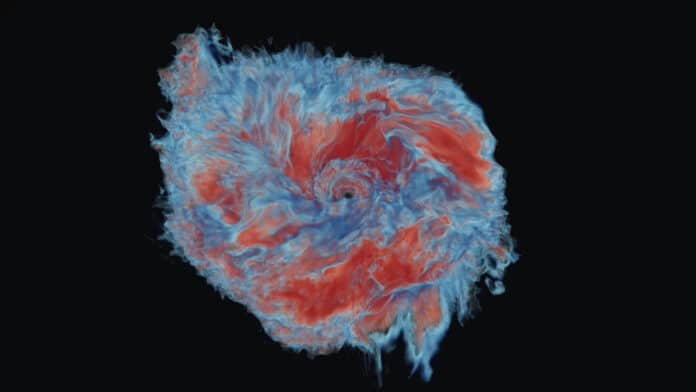Neutron stars form when big stars end their lives. They squeeze a lot of mass into a tiny space, making a super-dense star about 10 kilometers wide. In 2017, scientists saw the results of two neutron stars colliding: gravitational waves and bursts of radiation, including gamma rays.
The multi-messenger detection of the gravitational-wave signal GW170817, the corresponding kilonova AT2017gfo, and the short gamma-ray burst GRB170817A, as well as the observed afterglow, has delivered a scientific breakthrough. For an accurate interpretation of all these different messengers, one requires robust theoretical models that reliably describe the emitted gravitational wave, the electromagnetic emission, and dense matter.
Using a new software tool, a team involving the Max Planck Institute for Gravitational Physics and the University of Potsdam has developed a method to simultaneously model these observable signals of a kilonova.
Additionally, scientists use information from radio and X-ray observations of other neutron stars, along with calculations in nuclear physics and data from experiments with heavy-ion collisions on Earth. Until now, these different data sources have been studied separately, and sometimes, scientists use other models to understand the information.
Peter T. H. Pang, a scientist at Utrecht University, said, “By analyzing the data coherently and simultaneously, we get more precise results.”
This new method will assist in studying how matter behaves under highly high densities. It will also improve our understanding of the universe’s expansion and help us figure out the extent to which heavy elements are created when neutron stars collide.
The new method was used to study the first and, so far, only observation of a binary neutron star merger with multiple messengers. This event, found on August 17, 2017, generated gravitational waves due to the stars orbiting each other, detected by Advanced LIGO and Advanced Virgo.
As the stars merged, they expelled newly formed heavy elements. Some of these elements decayed, raising the temperature. This thermal radiation led to an optical, infrared, and ultraviolet electromagnetic signal, detected up to two weeks later. A gamma-ray burst from the merger ejected more material, and the interaction with the surrounding medium produced X-rays and radio emissions observable over days to years.
The gravitational-wave detectors are now in their fourth observing run. Scientists eagerly await the next neutron star merger detection, which could happen anytime. They’re excited to apply the tool they developed to further understand and analyze these cosmic events.
Journal Reference:
- Pang, P.T.H., Dietrich, T., Coughlin, M.W. et al. An updated nuclear-physics and multi-messenger astrophysics framework for binary neutron star mergers. Nat Commun 14, 8352 (2023). DOI: 10.1038/s41467-023-43932-6
